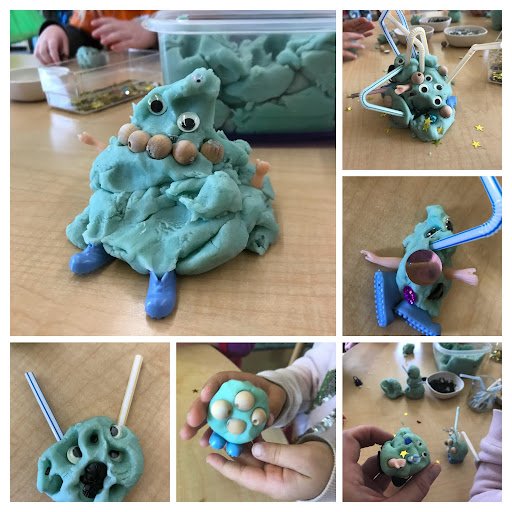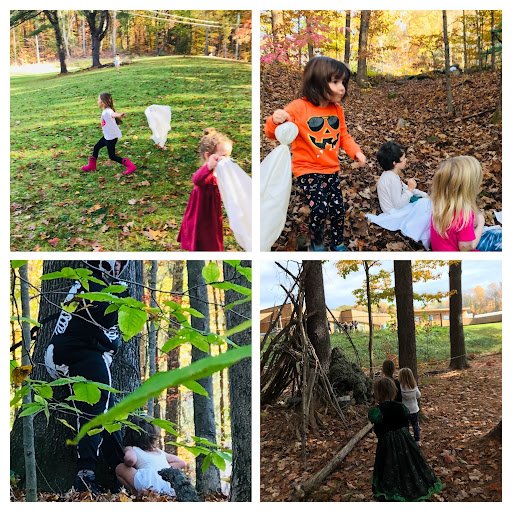The Origins of Halloweek in The Super Primes (4 year-olds)
“There is a child in every one of us who is still a trick-or-treater looking for a brightly-lit front porch.” — Robert Brault
For as long as I can remember I have loved Halloween. For the seven years I have been a Center School teacher, I have shared my passion for Halloween with both my students as well as the larger Center School community. Any student who I have taught can recall some bit of the raucousness that would eventually become Halloweek, a weeklong celebration of Halloween. At its start I knew that this holiday had the potential to really scare kids. It made me think of my own experiences as a kid in a less thoughtful time when there was no shield from Halloween fright. My mother could not control what her children would see as we hustled along trick or treating from bodega to apartment building. She could not protect me from the wildness of the older kids after dark, the fake blood and the frightful sounds. The fear was quick and faceless by its very nature without explanation or guidance. I just had to learn how to deal with being scared of it. As a result, much of the fear went unprocessed. I had to muscle through it like many of the kids of my time.
As Halloween celebrations grew into Halloweek, so grew the rich possibilities for educational connections to be made for my students. Something I have come to find so cool about Halloween as a teacher of some of the littlest humans is to use the unpredictability of this celebration to help students begin to parcel out the differences between scary make believe and real-life danger. Halloween could be a perfect segue for littles to balance their autonomy with its limitations when in contact with outside forces beyond their control.
I knew I could do more than just teach them how to just get through the fright of Halloween. I believed that they could understand more about being scared; they could really start navigating their own way through the big idea of fear. They could break down the differences between rational and irrational fear, arming them with some perspective that can inform their reactions. If I helped them put a face and words together to understand the scary, if I helped them to categorize and identify scary imaginative things and real life danger things then I have given them a framework to start to process fear.
Scary vs Dangerous
"Halloween wraps fear in innocence, as though it were a slightly sour sweet. Let terror, then, be turned into a treat."– Nicholas Gordon
As Halloween approaches, often this age group starts to connect the idea of safety as something they themselves can maintain, versus something they sometimes cannot control. These conversations often happen at mealtimes. Inside, we grapple with the complexities of fear by unpacking our pretend play. We discuss instances both in school and outside of school that make us scared. We then start to differentiate between identify real dangers like predatory animals, natural dangers like lava, lightning, fire, floods, cars, knives, things we shouldn’t do without supervision, vs with bad dreams, zombies, vampires, “evil” witches, mummies, monsters, scary characters within movies and books become a part of their sharing. We begin reading Halloween-themed stories in our classroom, and friends begin discussing plans for their Halloween costumes. We try to debunk imaginary fears by questioning what makes them unsafe. These conversations help dispel the threat of imaginary scary things while reasserting healthy reality- based fears which often keep us safe. Though Halloween-specific, much of this work is directly in line with developmental growth in play. As a play-based learning community we can't really ask for a better fit than Halloween to push us forward.
"It's as much fun to scare as to be scared." — Vincent Price
Outside, it is interesting to see year after year fears surfacing as a big theme within the kids' pretend play. Chase play becomes more urgent, the obstacles and pretend dilemmas more intense. Instead of running from nondescript bad guys or natural disasters, and temporary “problems” that need solutions, characterizations of fear begin to grow. The pretend threats shift toward villains, and boundlessly reflective creatures of their imagination paired with some fears rooted in reality. As a result, there is a rise in defense, i.e. more battling alongside retreat in this pretend play. More opportunities emerge for them to explore mortality, against pretend life threats. We watch as elaborate riffs on scenarios and tactics used to defend and attack, and mid game roll changes are concocted in breathless huddles pushing the play forward. As if on cue, monsters, zombies, poison, traps, start to invade even the most pretend play themes like family, kitty family, shelter building etc. All of a sudden it's about defense. Everyone is trying to escape something.
Inevitably this play becomes too much for some and we remind them that they are armed with a tactic to help them advocate for their needs in this play. Our universal symbol is the classic “timeout” signal made by making a capital T with your hand. When a friend sees this symbol they have to stop playing and listen to the person using it. That person can then relay their message about their needs. Sometimes this process ends with an amicable shift to a less uncomfortable theme, other times it is used to end the participation of the individual. This reinforces the idea of consent. This reminds friends of how permission of an individual can be revoked at any moment and this must be respected.
Happy Halloween from the Super Primes!



